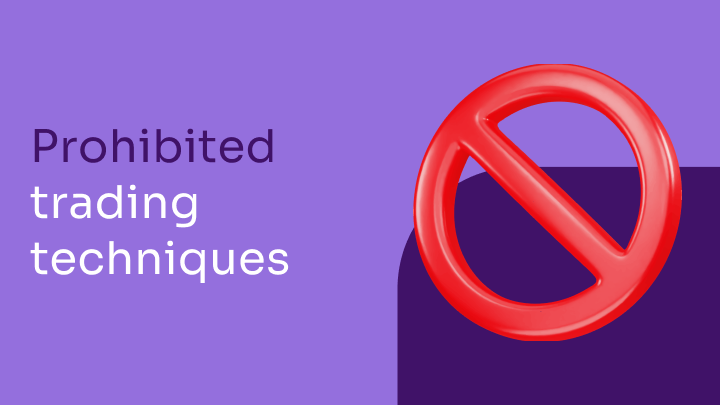Trading practices that won’t get you far at Fintokei
At Fintokei, we're all about opening up big opportunities to level up your trading game. But there are still some rules you have to play by.

We started Fintokei to help aspiring traders like you make it big in the trading world. Whether you’re lacking in knowledge, skills, or just capital to start trading, we’ve got your back.
Our mission is to teach you how to trade smartly—following a plan and keeping your emotions in check. If you nail this approach, there’s plenty of room for you to grow with us. But hey, there are still some ground rules we need you to stick to.
Modern prop trading draws in all sorts of traders. Some are genuinely eager to learn the ropes, analyze markets, and minimize losses. Others are just in it for the big payouts, not caring much about the journey. At Fintokei, we are aware of various such “speed traders” that’s why we have compiled a list of prohibited trading techniques and practices that lean closer to gambling than real trading.
Why aren’t these practices allowed in Fintokei?
It’s crucial to understand that our business relies on the expertise of conscientious and trustworthy traders. We aim to replicate the trades of top performers in real market conditions and profit from their success. Additionally, we’re keen on offering professional partnerships to these traders.
Given that the trading practices outlined in this article often resemble gambling or even fraud, they simply don’t fit our model. So beware of engaging in such practices as it can put you in a risk of losing your account or breaching a trading challenge.
Practices We Don’t Tolerate at Fintokei
Copying Other People’s Signals
If we’re aiming to discover and cultivate genuine trading talent and prepare traders to handle real investor capital, we simply cannot tolerate copytrading. Imagine being an investor who entrusts significant funds to someone only to find out they’re just mimicking others’ trades.
At Fintokei, we strictly prohibit copying signals from other traders or allowing third parties to manage accounts. Engaging in these practices will result in immediate account termination.
✅ Similar Technique Allowed: Copying your own trades
However, if you manage your own account with a broker and simply replicate your own trades onto a trading account at Fintokei, that’s perfectly fine. Just be aware that we reserve the right to verify the ownership of the account from which trades are copied.
Use of Trading Robots Created to Pass a Challenge
While we do permit certain standard Expert Advisor systems (EAs) at Fintokei (more details on these later), we draw the line at robots crafted solely to pass a trading challenge.
These so-called High-Frequency Trading (HFT) robots are designed to churn out a massive number of trades in record time. Not only does this strain the servers running prop trading company accounts, but it also poses a hidden issue.
HFT robots are often engineered to help users breeze through the first round of a trading challenge, only to mysteriously malfunction in subsequent rounds. Developers of these HFT robots then attribute these glitches to minor bugs, promising quick fixes and urging users to try (and buy) again. But there’s a catch: all profits from these endeavors end up lining the pockets of the prop trading company, which conveniently permits HFT.
We’ll leave it to you to decipher the relationship between HFT robot creators and prop trading firms, along with the realization that you’ll likely pay more cash for a similar robot than for one of our ProTrader challenges.
Let’s be crystal clear: the use of HFT or similar robots is strictly prohibited at Fintokei and will result in immediate account termination.
Martingale and Aggressive Averaging
This practice involves ramping up the size of positions despite unfavorable market conditions. Traders who adopt this highly risky method do so in the hopes of gradually turning losses into profits.
The issue with martingale and aggressive averaging is that it completely disregards the losses incurred along the way, fixating solely on the potentially lucrative rewards down the line.
Our goal is to equip our traders with the skills to trade with significant capital, making their strategy results appealing to potential future investors. However, trading using martingales and aggressive averaging is so precarious that it’s unlikely to attract any sensible investor.
✅ Similar Technique Allowed: Standard Price Averaging
On the other hand, investing consistent amounts at regular intervals, regardless of market fluctuations, is a methodical and risk-managed approach that aims to counteract the effects of market volatility.
However, it’s essential to note that the distinction between standard and aggressive averaging can be subtle. We recommend consulting our FAQ for a detailed definition of aggressive averaging. There, you’ll find specific examples and a helpful table to determine where your approach falls within this spectrum.
Our intention is certainly not to hastily close accounts or create inconvenience for traders striving to pass the trading challenge. Our primary aim is to safeguard ourselves from the growing number of fraudulent traders who exploit the rules of prop trading and evaluation firms.
David VargaCo-founder
Tick Scalping
Let’s discuss tick scalping. This strategy involves rapidly entering and exiting trades to capitalize on small price movements known as ticks. However, engaging in excessive tick scalping can result in the closure of your Fintokei account. While we aim to replicate our traders’ successful trades in real market conditions, tick scalping presents challenges due to slippage issues.
For a trade to be classified as tick scalping, it must have a duration of less than 15 seconds. Trades lasting longer than this are considered standard scalping, which is permissible.
It’s important to note that inadvertently executing a trade lasting 15 seconds or less does not automatically classify you as a tick scalper.
A trader is identified as a tick scalper if:
- They consistently open trades lasting less than 15 seconds.
- These trades account for over 10% of their total trading volume on any given day.
Exceeding the 10% threshold on a single day will result in a warning. Continued breaches may lead to account termination. If a trader’s tick scalping volume exceeds 50% in a day, the account will be immediately closed without further recourse.
Hedging Across Multiple Accounts and Clients
We agree that hedging positions across multiple accounts might sound kinda smart, but at Fintokei, we’re all about talent, not just any old trickster 🙂 When two traders in two different accounts team up and place identical trades but in opposite directions, sharing any profits or costs, it’s not exactly what we’re after in terms of trading talent – especially when we’re talking about handling real investor cash.
✅ Similar Technique Allowed: Standard Price Averaging
Now, opening opposite positions in the same trading instrument within the same account? That’s just good risk management. It helps keep traders and investors safe from any nasty surprises in the market. And that kind of hedging is perfectly okay with us.
Did you know? At Fintokei, you’ll receive a virtual capital account within just 24 hours of completing a challenge, significantly faster than our competitors’ 5 to 9 days. Similarly, our payouts are processed swiftly, typically within 1 business day, while our competitors may take up to 5 to 14 days. It’s all about efficiency and ensuring you get started on your trading journey without unnecessary delays!
Creating New Accounts with Different Email Addresses
Gambling traders often try to bypass our rules. Instead of reflecting on their risky trading habits and aiming to trade like real professionals, they look for ways to continue gambling. Since our monitoring system links clients to their email addresses, they see a simple solution: create new accounts with different email addresses and keep going.
That’s why at Fintokei, we’ve decided to treat creating new accounts under different email addresses than the original one as a prohibited practice.
✅ Similar Technique Allowed: Unlimited Accounts Linked to One Email
We don’t want to stop our traders from opening new accounts or taking on new challenges. Diversifying risk is actually a very smart strategy. Many of our traders pass the evaluation with two accounts and then switch between them. If one account gets too close to the drawdown limit, they move to the other and let the risky one cool off. It’s often a better approach than burning an account, starting a new challenge, and repeating the cycle. This way, traders stay in control while following the rules.
These trading techniques are perfectly okay with us!
Since we don’t want to wrap up on a negative tone and dwell solely on bans and prohibitions, let’s explore the techniques and practices that are permitted here at Fintokei. It’s worth noting that while our competitors often impose bans or restrictions, we take a different approach.
Trading News
Fundamental analysis – the real cornerstone of trading. When handled correctly it can pave the way for some serious profits. Here at Fintokei, if you know of some upcoming market event, you’re free to ride the volatility wave caused by big news releases, no strings attached. Unlike some other big prop trading companies, we don’t put the brakes on news trading.

Standard Trading Robots/EAs
Now, when it comes to trading robots, we’ve got a mixed bag. While we’re not fans of those super-fast HFT robots or ones designed to ace trading challenges, we really don’t mind the other types. Think robots that help you set Stop Loss or Take Profit levels, make entering positions a breeze, or improve your old MT4 platform. Bottom line? We do not ban EAs across the board at Fintokei.




